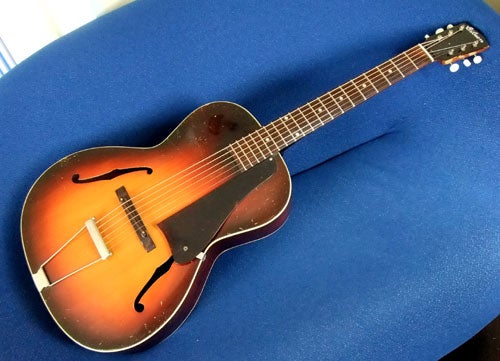
A year later the model was offered with two P 90 pickups and called the ES-125TD. The thin-line models depth was 1 3/4 inches. All accouterments remained the same except for the body depth, which originally was 3 1/2 inches. In 1956, Gibson updated the model, by offering it in their thin-line series, renaming it the ES-125T. The model was reintroduced in 1946 when Gibson once again geared up for guitar production. In 1942, production stopped, due to the war. The nickel plated tail-piece was trapeze style. The tuners, once again, were made by Kluson. The bridge was compensated and made of rosewood. The input jack was on the lower rim of the body. The electronics remained similar to prior models a single volume and tone potentiometer, but now featured gold tinted bonnet style knobs. The guitars pick-guard was made of tortoise-shell style celluloid. The headstock, like the previously mentioned guitars, was unadorned except for the Gibson logo silk-screened in gold lettering across the top. The unbound solid Honduras mahogany neck was capped with a Brazilian rosewood fretboard which was originally topped with pearloid dot markers. The pickup was now Gibson's P90 dog-eared unit with adjustable pole-pieces. The back and sides were also made of maple.


The body on this guitar was now 16 1/4 inches in width and came with a laminated arched maple top, which became Gibson's standard on it's electric hollow body instruments. In 1940 this changed to Gibson's first pole magnet pickup.īy 1941, the ES-100 was dropped from the line-up and replaced with the Gibson ES-125 model. Originally the pickup on this model was a blade style unit. The strings were held in place by a trapeze tail-piece. The neck was unbound and capped with a rosewood fretboard. The guitars arched top was carved and made of spruce. Within the guitars body were two sound-posts. It's body was bound on the top and bottom. The ES-100 was two inches shorter than the ES-150, having a body depth of a mere 14 1/4 inches. A pickup was added to the body and placed in the bridge position. This instrument was based on Gibson's L-50 arch top acoustic guitar. The screws also adjusted the pickups height.įollowing the success of this guitar, in 1938 Gibson introduced a budget model known as the model ES-100. The instrument was 16 1/4 inches wide and had a single blade pickup in the neck position that was held in place by three screws that were visible on the bodies top under the strings.

This was the ES-150, commonly known as the Charlie Christian model. For the ES-125, the original case would likely have been a faux-gator fibre (cardboard) case, so this is a significantly better option.Gibson introduced it's first commercially successful electric guitar in 1936. These guitars sound great for jazz or, slightly overdriven, for blues.Ī period Gibson brown hard shell case is included, slightly oversize. The fretwear is minor and the frets look original. The fingerboard and bridge are rosewood, and typical of the period, that specifically means Brazilian Rosewood. Like most electrified archtops of the period, these guitars are made with laminate for the top, back and sides, with a mahogany neck.

The single P-90 pickup is in an interesting location, between the ‘standard’ neck or middle positions. Otherwise the hardware and fret work seems original and in good condition. This wonderful guitar is in good condition, and largely original though the tuners have been replaced with drop-in vintage replicas, and the trapeze tailpiece has been changed. Y represents 1953, and this guitar was the 26th in batch 4011. FON’s were used at various times, and from 1952 to 1961 started with a letter code, counting down from Z to Q.
#GIBSON ES 125 1940S FULL#
This Gibson ES-125 in the original full body, no cutaway, one pickup configuration, is clearly dated to 1953 from the FON, Factory Order Number stamped on the inside back and visible from the treble F-hole.
#GIBSON ES 125 1940S FULL SIZE#
Several variants of the ES-125 were made, including full size body, thin body, thin body with cutaway, and one or two pickups. Wartime production ended in 1943, and resumed from 1946 to 1970. Produced as an entry level electrified archtop guitar, the Gibson ES-125 first appeared as the ES-100 in 1938, with a name change in 1941.


 0 kommentar(er)
0 kommentar(er)
